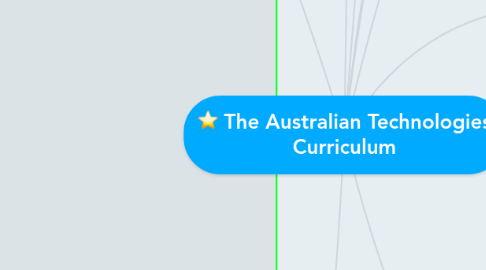
1. Subjects (Technologies)
1.1. Design and Technologies
1.1.1. Strands
1.1.1.1. Knowledge and understanding
1.1.1.1.1. Technologies and Society The use, development and impact of technologies in people's lives.
1.1.1.1.2. Technologies Contexts - Technologies and design across a range of technologies contexts:
1.1.1.2. Processes and production skills
1.1.1.2.1. Creating Solutions By:
1.1.2. Achievement Standards
1.1.3. Aims to develop the knowledge, understandings and skills to ensure that, individually and collaboratively, students:
1.1.3.1. produce designed solutions suitable for a range of Technologies contexts by selecting and manipulating a range of materials, systems, components, tools and equipment creatively, competently and safely; and managing processes
1.1.3.2. understand the roles and responsibilities of people in design and technologies occupations and how they contribute to society.
1.2. Digital Technologies
1.2.1. Strands
1.2.1.1. Knowledge and understanding
1.2.1.1.1. Digital Systems - the components of digital systems: hardware, software and networks and their use.
1.2.1.1.2. Representation of Data - how data are represented and structured symbolically.
1.2.1.2. Processes and production skills
1.2.1.2.1. Collecting, Managing and Analysing Data - the nature and properties of data, how they are collected and interpreted.
1.2.1.2.2. Digital Implementation - the process of implementing digital solutions.
1.2.1.2.3. Creating Solutions By:
1.2.2. Achievement Standards
1.2.3. Aims to develop the knowledge, understandings and skills to ensure that, individually and collaboratively, students:
1.2.3.1. use computational thinking and the key concepts of abstraction; data collection, representation and interpretation; specification, algorithms and implementation to create digital solutions
1.2.3.2. confidently use digital systems to efficiently and effectively transform data into information and to creatively communicate ideas in a range of settings
1.2.3.3. apply systems thinking to monitor, analyse, predict and shape the interactions within and between information systems and understand the impact of these systems on individuals, societies, economies and environments.
2. General Capabilities
2.1. Literacy
2.2. Numeracy
2.3. ICT
2.3.1. Digital Technologies
2.3.2. Design and Technologies
2.4. Critical and creative thinking
2.5. Personal and social capability
2.6. Ethical understanding
2.7. Intercultural understanding
3. Australian Curriculum Year Level Bands
3.1. Foundation - Year 2
3.2. Years 3 and 4
3.3. Years 5 and 6
3.4. Years 7 and 8
3.5. Years 9 and 10
4. Student Diversity
4.1. Students with disability
4.1.1. draw from content at different levels along the Pre-primary – Year 10 sequence.
4.1.2. use the general capabilities learning continua in Literacy, Numeracy and Personal and social capability to adjust the focus of learning.
4.1.3. Adjustments to the delivery of some practical aspects of lessons.
4.1.4. adjustments to assessment of students with disability.
4.2. English as an additional language or dialect
4.2.1. may require additional time and support, along with teaching that explicitly addresses their language needs.
4.3. Gifted and talented students
4.3.1. providing them with opportunities to work with learning area content in more depth or breadth.
4.3.2. emphasising specific aspects of the general capabilities learning continua .
4.3.3. focusing on cross-curriculum priorities.
5. Cross-Curriculum Priorities
5.1. Aboriginal and Torres Strait Islander histories and cultures.
5.1.1. explore how Aboriginal and Torres Strait Islander Peoples' capacity for innovation is evident.
5.2. Asia and Australia's engagement with Asia.
5.2.1. diverse and authentic contexts
5.3. Sustainability.
5.3.1. anticipating and balancing economic, environmental and social impacts.
6. Key Ideas
6.1. Creating preferred futures
6.1.1. consider how solutions that are created now will be used in the future
6.2. Project management
6.2.1. develop skills to manage projects to successful completion through planning, organising and monitoring timelines, activities and the use of resources.
6.3. Thinking in Technologies
6.3.1. Systems thinking
6.3.1.1. understand systems and work with complexity, uncertainty and risk
6.3.2. Design thinking
6.3.2.1. use of strategies for understanding design needs and opportunities, visualising and generating creative and innovative ideas, planning, and analysing and evaluating those ideas that best meet the criteria for success.
6.3.3. Computational thinking
6.3.3.1. a problem-solving method that is applied to create solutions that can be implemented using digital technologies. It involves integrating strategies, such as organising data logically, breaking down problems into parts, interpreting patterns and models and designing and implementing algorithms.
6.4. ICT
6.4.1. Students develop explicit knowledge, understanding and skills relating to operating and managing ICT and applying social and ethical protocols while investigating, creating and communicating.
6.5. Safety
6.5.1. safe use of technologies as well as risks that can impact on project timelines.
6.6. Animal ethics
6.6.1. comply with the Australian code of practice for the care and use of animals for scientific purposes.
